Western Mountaineering Alpinlite vs UltraLite: Which Premium Sleeping Bag Is Right For You?
A comprehensive comparison of Western Mountaineering's most popular 20°F sleeping bags, analyzing their differences in design, performance, and ideal use cases
Key Findings
- The primary difference between these premium sleeping bags is their cut - Alpinlite offers a wider, more comfortable design while UltraLite provides a trimmer, more thermally efficient fit
- Both bags share the same superior 850+ fill power down and temperature rating, with identical construction quality and materials
- The Alpinlite weighs just 2 ounces more than the UltraLite but provides 5 inches of additional shoulder room
- Your sleeping style, body type, and comfort preferences should be the deciding factors rather than technical specifications
